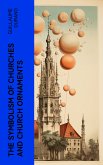In "The Symbolism of Churches and Church Ornaments," Guillaume Durand presents a compelling exploration of the intricate relationship between architectural elements and their spiritual significance within the Christian faith. This scholarly work illuminates the rich tapestry of medieval church designs, employing a blend of theological insights and historical context to analyze how structures and decorations reflect doctrinal beliefs. Durand'Äôs literary style is characterized by meticulous detail and an engaging narrative flow, making complex theological concepts accessible while placing them within the broader cultural framework of the time. Guillaume Durand, a prominent cleric and scholar of the 14th century, was deeply immersed in the theological and cultural currents of his era. His position as a bishop, along with his extensive involvement in ecclesiastical affairs, informed his understanding of the symbolic language employed in church architecture. As an advocate for the unification of faith and knowledge, Durand drew upon both his spiritual leadership and scholarly pursuits to articulate the profound meanings embedded in ecclesiastical designs, showcasing how they communicate divine truths to the faithful. This book is an invaluable resource for theologians, historians, and architects alike, inviting readers to appreciate the layers of meaning within sacred spaces. Whether you are seeking a deeper understanding of religious symbolism or the confluence of art and spirituality, Durand'Äôs work offers a thought-provoking analysis that enriches our appreciation of medieval church heritage.
Dieser Download kann aus rechtlichen Gründen nur mit Rechnungsadresse in A, B, BG, CY, CZ, D, DK, EW, E, FIN, F, GR, H, IRL, I, LT, L, LR, M, NL, PL, P, R, S, SLO, SK ausgeliefert werden.









